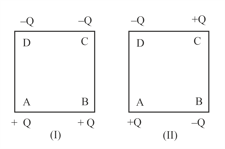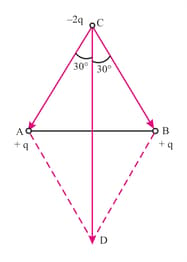EASY
12th CBSE
IMPORTANT
Earn 100
Plot a graph showing the variation of coulomb force versus where is the distance between the two charges of each pair of charges: and Interpret the graphs obtained.

Important Questions on Electric Charges and Field
EASY
12th CBSE
IMPORTANT
Two point charges, and are located at points and respectively. Find the electric field, due to both these charges, at the point .
EASY
12th CBSE
IMPORTANT
Four point charges are placed at the four corners of a square in the two ways (i) and (ii) as shown in Fig. Will the electric field at the centre of the square, be the same or different in the two configurations and why?

EASY
12th CBSE
IMPORTANT
Four point charges are placed at the four corners of a square in the two ways (i) and (ii) as shown in Fig. Will the electric potential, at the centre of the square, be the same or different in the two configurations and why?

EASY
12th CBSE
IMPORTANT
Three chargesand are placed at the vertices of an equilateral triangle. What is the dipole moment of the system?

MEDIUM
12th CBSE
IMPORTANT
Two similar balls each having mass and charge are hung from a silk thread of length . Prove that equilibrium separation,
when each thread makes a small angle with the vertical.
MEDIUM
12th CBSE
IMPORTANT
Five point charges, each of value coulomb are placed on five vertices of a regular hexagon of side metres. Find the magnitude of force on a charge coulomb placed at the centre of the hexagon.
EASY
12th CBSE
IMPORTANT
A simple pendulum consists of a small sphere of mass suspended by a thread of length . The sphere carries a positive charge . The pendulum is placed in a uniform electric field of strength directed vertically upwards. With what period will the pendulum oscillate if the electrostatic force acting on the sphere is less than the gravitational force?
EASY
12th CBSE
IMPORTANT
Four particles, each having a charge , are placed on the vertices of a regular pentagon. The distance of each corner from the centre is ''. Determine the electric field at the centre of the pentagon.
